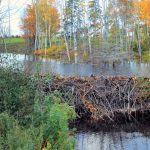When more than an acre of corn disappeared from his field, J. Brian Carroll assumed a hungry bear ate it. Then he noticed a beaver slide, a slick, muddy trail that tracked to an adjacent swamp.
“Beavers probably cut down an acre or two worth of corn,” said Carroll, an Isle of Wight County Farm Bureau member who also grows cotton and soybeans. “I think they took the corn for materials to build the dam.”
Beavers create new habitats that benefit a variety of species, but beaver damage in the southeastern U.S. is estimated to cost millions annually. Beavers are responsible for timber and agricultural crop loss and damage to roads and septic systems through flooding and landscape destruction.
Virginia farmers, particularly in southern counties, are continually implementing mitigation strategies to disrupt beaver activity. State law allows elimination of nuisance beavers, but coexistence is possible.
“You’re not going to shoot them to get rid of them,” Carroll said. While culvert guards and pond-leveling devices that bypass dams are effective, “We found the ‘beaver deceiver’ to be the best thing for us.”
Beavers work hard to maintain a desirable water level in their habitat so the portal to their home within a dam can safely be accessed underwater. The sound of flowing water triggers beavers’ instincts to plug leaks with mud and sticks, so wildlife control experts exploit that instinct.
Kevin Cornwell of Cornwell’s Wildlife Control taught Carroll how to build and install beaver deceivers. These are long trapezoidal cages with too many holes to plug, far from the drainage source beavers intend to clog. Cornwell said the devices frustrate beavers until they move elsewhere. If a resident family is removed, deceivers discourage new beaver activity.
Destroying an active dam is futile, he said.
“You can’t just knock down a dam three times and expect the beavers to leave,” Cornwell said. “Say something happens to your house—your basement gets flooded—you’ll still do whatever possible to stay at that location.”
When removal is not feasible or mitigation fails, a professional assessment by the U.S. Department of Agriculture’s Animal and Plant Health Inspection Service’s (APHIS) Wildlife Services office in Mosely can help landowners foster coexistence.
Dr. James A. Parkhurst, associate professor in the Virginia Tech Department of Fish and Wildlife Conservation, said beavers are not overpopulated. However, most conflicts reported to the Virginia Wildlife Conflict Helpline occur in the southern Coastal Plain—prime beaver habitat and rich farmland.
He said beavers damage crops and obstruct farmland drainage systems that cause field flooding. APHIS experts can investigate and offer site-specific mitigation techniques.
“The intent is often not to eliminate the beaver, but reduce the water to a level you can live with that doesn’t pose a serious challenge to operations,” Parkhurst said.




